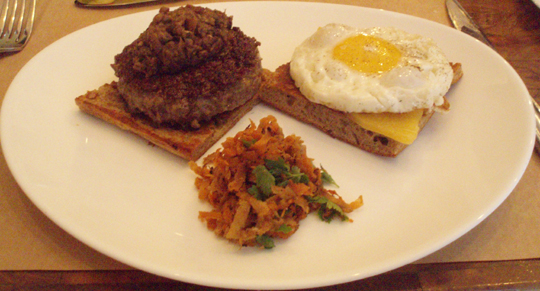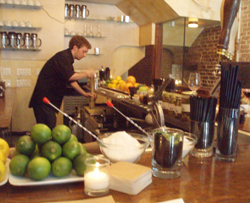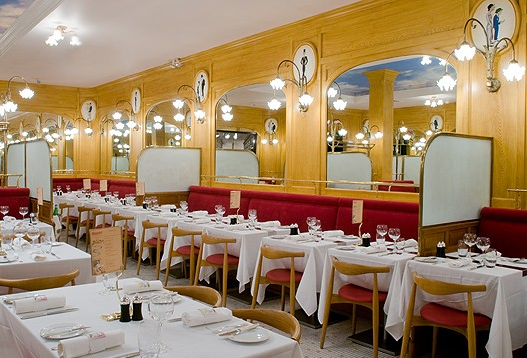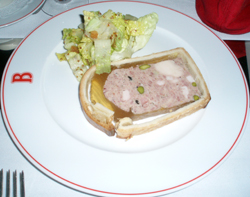

Part of a critic’s job is to direct readers to great restaurants they wouldn’t otherwise discover. Unfortunately, most of New York’s professional critics seldom have time to do so. With just one published review per week, it’s all they can do to keep up with new restaurants that, for all intents and purposes, must be reviewed.
 So we were gratified to see Frank Bruni’s review of La Sirène—a restaurant we’d never heard of. We’re not sure how Bruni even found the place. When it opened in May 2007, every critic in town ignored it, except for Time Out New York, which awarded four-of-six stars. (TONY’s ratings are a bit odd sometimes, but they have one of the most thorough dining-out sections in town.)
So we were gratified to see Frank Bruni’s review of La Sirène—a restaurant we’d never heard of. We’re not sure how Bruni even found the place. When it opened in May 2007, every critic in town ignored it, except for Time Out New York, which awarded four-of-six stars. (TONY’s ratings are a bit odd sometimes, but they have one of the most thorough dining-out sections in town.)
Bruni awarded one star, but you shouldn’t be deceived by that. One star is supposed to mean “good,” and though the stars have been debased over the years, this was one of those rare reviews in which one star was a compliment: Bruni loved the place.
So did we.
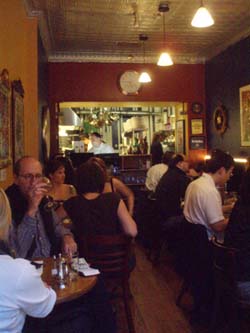 The name means “The Mermaid,” perhaps a nod to chef Didier Pawlicki’s Marseille roots. The minimal décor in this tiny slip of a restaurant is faintly nautical, though there’s red meat on the menu too, in addition to the obligatory fish and seafood, especially mussels.
The name means “The Mermaid,” perhaps a nod to chef Didier Pawlicki’s Marseille roots. The minimal décor in this tiny slip of a restaurant is faintly nautical, though there’s red meat on the menu too, in addition to the obligatory fish and seafood, especially mussels.
Pawlicki is a constant presence in the dining room, explaining himself and seeking our approval. He served the hangar steak at a table next to ours, and said, “Here it is, medium. I refuse to cook it medium well.” At another, he served sea bass and explained how much of the fish gets thrown away to yield just one filet. To us, he explained the sweet–sour balance of the chocolate in the profiteroles.
Time Out New York called Pawlicki the “Cockiest chef with the goods to back it up.” (The little plaque the magazine gave him is hanging proudly on the wall.) On Citysearch.com, Pawlicki adds a personal comment to every review. The overwhelming majority of those reviews are positive.
On the classic bistro menu, which changes seasonally, appetizers are $7.50–$13.95, entrées $19.50–$28.50, desserts $7.50–$12.75. There are four different preparations of mussels, $12.75 as an appetizer, $21.75 as an entrée. It is probably time that Pawlicki rounded his prices off to the nearest dollar.
These prices have risen considerably since TONY reported that the average entrée was just $20. But La Sirène is more-or-less in line with other places serving food of comparable quality. The restaurant is also BYOB, and apparently has no plans to obtain a liquor license. This reduces the de facto cost of dinner considerably.


Some of the menu descriptions mix French and English in almost comical ways, such as “Brie, Blue Cheese et Chèvre Rotis sur Croutons a l’ail et Salade Verte” ($13.75); that’s brie, blue and goat cheese on garlic croutons over greens. Our other starter, Gateaux de Crabe ($11.85), speaks for itself.
Both appetizers were adequate but unmemorable, and the plating of the crab dish wasn’t very attractive.


Hangar Steak, or Onglet Poêlé à la Facon Luchonaise ($24.50) was wonderful. The menu pronounces it the “Signature Main Course.” The steak was lightly seared, cut in thin ribbons fanned around the plate, served with a garlic and parsley sauce, and with a brick of sweet potatoes in the center. Hangar steak can sometimes be tough, but Pawlicki’s version was so tender you’d think it was rib-eye.
 My girlfriend had the terrific Kassoulet Toulousain de la Maison ($26.95), with cannellini beans, tomato, duck leg confit, bacon and pork sausage, all braised with “duck fat yummy!!!”
My girlfriend had the terrific Kassoulet Toulousain de la Maison ($26.95), with cannellini beans, tomato, duck leg confit, bacon and pork sausage, all braised with “duck fat yummy!!!”
The challenge with this dish is to ensure the ingredients maintain their clarity; the last two places I’ve had it, the cassoulet was over-cooked, and it the flavor had all boiled away. Here, it was just about perfect.
The entrées came with “veggies du moment” (left), served family style.

The profiteroles have apparently been controversial, with some diners complaining the chocolate was too bitter, though others seemed to love it. Pawlicki yanked it from the menu, but he was able to whip up a batch rather quickly when Frank Bruni and his friends asked for it.
Anyhow, it’s back, along with Pawlicki’s quirky description:
Grand Profiteroles au “Bittersweet” Chocolat (Good to Share)
Back on the Menu due to Overwhelming demand. (You like it, Good. You don’t, it will stay this time! This isn’t Hershey’s Chocolate, but Callebaut!
Pawlicki ain’t kidding when he says “Good to Share.” With three pastries, each stuffed with ice cream, and the whole plate slathered in chocolate and whipped cream, even two people will struggle to finish it. We certainly didn’t. We can understand the “overwhelming demand” for this excellent dish, but it’s the most expensive dessert on the menu ($12.75). It should probably be scaled back a bit.
The early TONY review referred to an “empty dining room,” but that isn’t the case now. La Sirène has been discovered, and it was full on a Friday night. There are two servers for twenty-five seats, but they’re patient and polished, despite the slightly hectic atmosphere. The ambiance is decidedly informal—you have to pass through the cramped kitchen to get to the restroom—but there’s a romantic rusticity here that is instantly endearing. We suspect that La Sirène will remain a neighborhood classic for some time to come.
Note that, except for AMEX, credit cards are currently not accepted.
La Sirène (558 Broome Street, just east of Varick Street, SoHo)
Food: *½
Service: **
Ambiance: *
Overall: *½
 Wednesday, April 30, 2008 at 08:09AM
Wednesday, April 30, 2008 at 08:09AM  Commerce,
Commerce,  Harold Moore,
Harold Moore,  Tony Zazula in
Tony Zazula in  BruniBetting
BruniBetting 




















